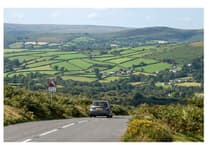Perfect walking weather greeted the group for the ascent to Roughtor on Bodmin Moor.
After the recent heatwave the 17 members walking were relieved to have a comfortable temperature for this 7-mile walk. Even though it was a generally cloudy day, there were still panoramic views to be enjoyed. On a clearer day, they would have been able to see across to the North Cornish coast.
A few spits of rain once or twice didn’t spoil a generally dry day and most of their waterproofs stayed firmly in the walkers’ backpacks. The terrain was a mix of open moorland with a few rocky and uneven climbs. The ascent to the summit of Brown Willy was fairly steep but was followed by easy open moorland tracks and a lovely woodland path to finish.
The group walked up the main track from Poldue Down towards Roughtor passing the memorial to 18-year-old Charlotte Dymond who was found brutally murdered near Roughtor in 1844. Her boyfriend was hanged for the murder despite protesting his innocence. Circumstantial evidence and a confession which appeared to be fake condemned him. The notorious trial and hanging of the young man found guilty of her murder is documented at Bodmin Gaol. A large crowd had gathered to attend his hanging and the police had to intervene to prevent a crush. Even before the trial had begun, a fete was held at Roughtor attended by some 10,000 people. There were donkey rides, refreshments, wrestling matches and other entertainments. A pole was erected where Charlotte’s body was found and penny ‘subscriptions’ were taken to view it.
Halfway up the tor the walkers stopped at the Holy Well which was originally discovered in 1970 then lost again and re-discovered and restored in 1994, becoming a scheduled monument. This is one of 7 holy wells on Bodmin Moor which form a distinct sub-group containing several of the major types of holy well. They provide important information on the nature of religious beliefs and practices and on the relationship between religion and the landscape during the medieval period.
Near the top of Roughtor are the remains of a large bronze age settlement consisting of 120 hut circles, small enclosures and fragments of field systems. On the other side of the tor are a number of hut circles and here the enclosures probably represent an economy based upon stock rearing and a little cereal cultivation. The extensive field system is likely from a later period when arable farming was more predominant. Roughtor is notable for its stone stacks and logan stones and at the top are the remains of the 14th century St Michael’s Chapel which may have been used as a beacon to guide travellers. The National Trust owned tor was given to the nation in memory of those of the 43rd Wessex Division who lost their lives during the second world war. A memorial can be found at the site of the chapel.
The group then made their way across Little Roughtor to Showery Tor with its spectacular granite stacks. This tor, thought to have been a prehistoric religious site, is encircled by a massive ring cairn made of piled stone and is the only natural formation known to have been framed in this way. From Showery Tor the group took a well-used track down to the De Lank River valley, an SSSI and SAC (Special Area of Conservation) with its wide variety of flora and fauna, also an important habitat for the otter.
Having dropped down into the valley it was then quite a climb up to the summit of Brown Willy which, at 420m above sea level, is the highest point in Cornwall. One theory about the large cairn on the summit is that it may have a calendric function as the sun rises over the cairn from nearby Stannon Stone circle. Or, it may simply be a burial mound, but it as never been excavated.
Lunch was enjoyed by the group at the summit before they picked their way down through stones and small boulders to join a rough path leading to an easy walk on open moorland. They soon reached the granite and quartz Lanlavery rock overlooking Crowdy Reservoir which was completed in 1973. Crowdy is a nature reserve with a bird hide. No water sports are permitted. Here in the autumn can be seen spectacular murmurations of sometimes several million starlings.
The walk ended with an easy stroll through the mature Lower Moor conifer plantation. Tea and cakes and cream teas were enjoyed at nearby Roughtor Farm.
As ever, new walkers are always welcome. Next week’s walk is from Dartmeet. Meet at the post office in George Street, Okehampton ready to leave at 9.30am. Where possible, we share cars so please be there in plenty of time for this to be organised so that the group can leave promptly. You should be suitably attired for all weather conditions, including sturdy footwear and bring a packed lunch.




.jpeg?width=209&height=140&crop=209:145,smart&quality=75)
Comments
This article has no comments yet. Be the first to leave a comment.